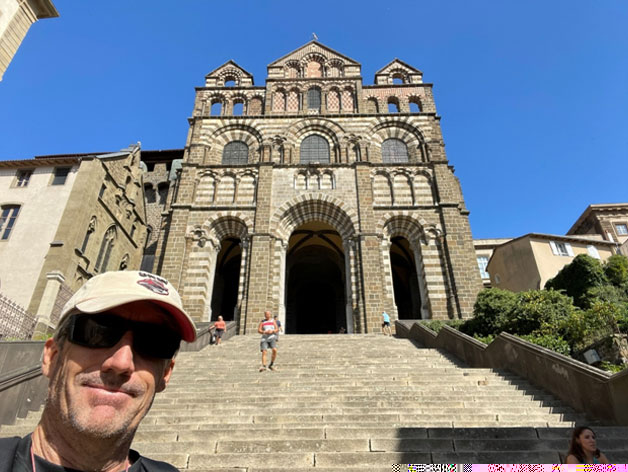Camino de Santiago (Part 1)
The Camino de Santiago, as it is known in Spanish, is a pilgrimage trail that starts at points all over Europe and usually ends in Santiago, Spain. It has been traveled by Catholic pilgrims for over 1,000 years. The cathedral in Santiago is where the remains of the Apostle James are purportedly kept. Pilgrims believed that the spirit of James would keep them safe on the Camino. The government took efforts to keep the Camino safe from the Moors in the south of Spain and the church went to great effort to shelter and give medical care to pilgrims.

Since about 1990, doing the Camino has come back into popularity. The growth rate in people completing the Camino grows by about 10% per year. Records show that 446,035 people completed it in 2023. That is an average of 1,222 per day, although daily completions vary quite a bit by time of year.
The Camino has always been open to everybody of all faiths. In the early years, it was one of three main pilgrimages in the Catholic church, the other two ending in Jerusalem and Rome. Today, I would estimate the percentage of pilgrims on the Camino who are Catholic is rather small. Based on people I spoke with, most pilgrims do it for spiritual reasons, a physical challenge, a vacation or some combination.
When I lived in Baltimore from 1992 to 2001, I section hiked about 200 miles of the Appalachian Trail (AT). I liked it. It is on my bucket list to return and finish it in the short period of my life between retirement and being too old to do it. In my circle of hiking friends, I’ve had conversations about the AT, the Pacific Crest Trail and other long-distance trails lots of times. In these conversations, the Camino de Santiago sometime would come up, but until several years ago I didn’t know much about it.
In 2015, I was visiting Germany. My cousin, who lives in Marburg, took me to visit Mainz. There his wife showed pointed out metallic shells laid out on the main street through the city. She explained how the Camino de Santiago went through Mainz with the shells marking the path all the way to Santiago, 2000 kilometers away.

The shell, as a fun fact, is the symbol of the Camino because it used to end in Fisterra, Spain, which is on the west coast and known as the “end of the earth,” because it was believed that was as far west as land extended. As proof one made it, they would collect a scallop shell, which were easily found on the beach. They also made for a handy spool/bowl on the way back.
A few years after that, I don’t remember exactly when, I befriended a world-traveler and adventurous friend named Susan. She mentioned she did a 500-mile section of the Camino and knowing our similar interests, highly recommend I do the same. Then earlier this year a friend of mine from my local hiking circle of friends posted about her Camino on Facebook, which significantly moved it up on my bucket list.
Fast forward to August of this year. I decided to skip Burning Man. If you’ll pardon the pun, I was a bit burned out from it after 2022 and 2023. However, I traditionally do some kind of adventure this time of year. Up to this point, my biggest adventure in 2024 was a mountain climbing trip to Mexico in January. By August, I was ready for another one. Something big.
At first my intention was to do a big road trip to road trip to Alaska with two friends. However, that fell through for reasons beyond my control. I then planned to do an Alaska trip by myself, bouncing around from place to place on the Alaska ferry. That turned out to be logistically hard to plan because the Alaska ferry was running on a limited schedule, due to a staffing shortage. In particular, there was no way to get between Juneau and points north like Homer.
It was dealing with the frustration planning an Alaska trip that I realized that it would be the perfect time to do the Camino. Unlike most pilgrims, I planned to do it on bicycle. I planned to leave on August 30 for Le Puy, France and return whenever I finished, which I estimated to be in three to four weeks. Mrs. Wizard pleasantly and surprisingly agreed to this plan.
In part 2 of my story, I’ll get into the adventure, beginning in Le Puy.
Source: Wikipedia page on Camino de Santiago

September 26, 2024 Puzzle Question
You are a cook in a remote area with no clocks or other way of keeping time other than a four-minute hourglass and a seven-minute hourglass. You also have a stove with water in a pot already boiling. The king asks you for a nine-minute egg, and you know he is a perfectionist and will be able to tell if you undercook or overcook the eggs by even a few seconds. How can you prepare the egg in nine minutes?
September 26, 2024 Puzzle Answer
- 1. Turn over both hourglasses.
- 2. When the four-minute hourglasses runs out of sand, turn it over. (time elapsed = 4 minutes)
- 3. When the seven-minute hourglass runs out of sand, turn it over. (time elapsed = 7 minutes)
- 4. When the four-minute hourglasses runs out of sand, turn seven-minute hourglass over. (time elapsed = 8 minutes)
- 5. When the seven-minute hourglass runs out of sand, serve the egg (time elapsed = 9 minutes)
October 17, 2024 Puzzle Question
Using a balance scale and four weights you must be able to balance any integer load from 1 to 40. How much should each of the four weights weigh?




